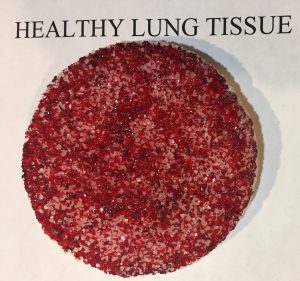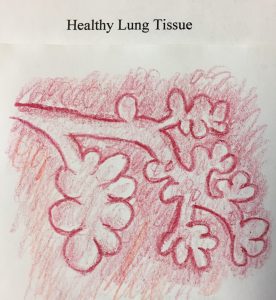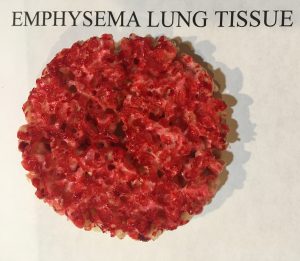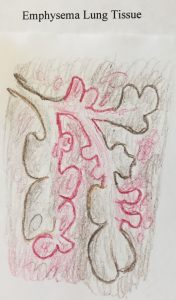For our project we chose to focus on emphysema. As active emergency medical technicians on an ambulance crew, COPD and emphysema are extremely common complaints that we see in the field. Emphysema is a form of chronic obstructive pulmonary disease (COPD) and it is distinguished by an abnormal increase in the size of air spaces distal to the terminal bronchiole, accompanied by deterioration of the alveolar walls. Our models demonstrate cross-sectional lung tissue. The healthy lung is shown by compact and more uniform alveoli. The emphysema lung tissue shows more damaged alveoli which consequently have much larger openings. It shows that over time, the walls of the alveoli have weakened, ruptured or collapsed. The cross sections are shown by styrofoam and rice crispy models. To highlight the good versus damaged alveoli, we have hand-drawn the alveolar sacs.




By covering the topic of emphysema, Darrel meets the objective for analyzing the effects of disease on function and structure of the respiratory system. He uses styrofoam to show how the lungs of a normal person have alveoli that are small, close together, and plentiful compared to the diseased lungs made from rice crispy. This is because emphysema targets the walls of the alveoli, damaging them so they lose their elasticity. Alveoli are unique in that they can inflate and deflate to accommodate the air coming in and out of the lungs. With emphysema, the alveoli are inflated, but can’t deflate, so they hold some old air in them at all times. Since the alveoli stay in an inflated state, it means they have less surface area, which leads to gases being exchanged at a lower amount and less quickly. This can be seen through the black colored alveoli. Since they are also holding old air, they can’t release or take in air as much. Some symptoms of emphysema are a distended chest, shortness of breath, and fatigue. The distended chest is due to the stretched out alveoli, the shortness of breath is because they can’t exchange gas as efficiently, and the fatigue is because the lungs have to work harder to get the same amount of oxygen as before the disease. The physical effects of emphysema are nicely shown in the pictures above, explaining how the lungs become damaged.
Taylor and Darrel did their STEAM project on emphysema which is a form of (COPD) chronic obstructive pulmonary disease. Those who suffer from COPD usually have a history of smoking, labored breathing or frequent coughing resulting in pulmonary infection. This disease causes the alveoli to gradually expand which causes the deterioration of the alveolar walls, capillaries, and gas exchange in affected areas to cease. Fibrosis of the lungs comes from chronic inflammation and because of the progressive loss of lung elasticity the bronchioles begin to collapse during expiration. The collapsing of the bronchioles traps large volumes of air and will affect the release carbon dioxide from exhalation. Their research shows that patients with severe COPD “expend 15% to 20% of their total energy supply just to breathe.â€
Their project consists of drawn examples of lung tissue in a healthy state and composed of emphysema. They also used a great visual with Styrofoam and rice crispy to display the affects emphysema has on healthy lung tissue. I was unaware of the actual effects of CPOD and feel as though Taylor and Darrel did an extraordinary job with their explanation and factual research on this disease. The damage caused by COPD is permanent, however, progress can be slowed by cessation of smoking. Treatment for mild to severe cases is supplemental oxygen and in some cases lung transplants and lung volume reduction surgery can be done. Objective focused on; Analyze the effects of disease on function and structure of the respiratory system.